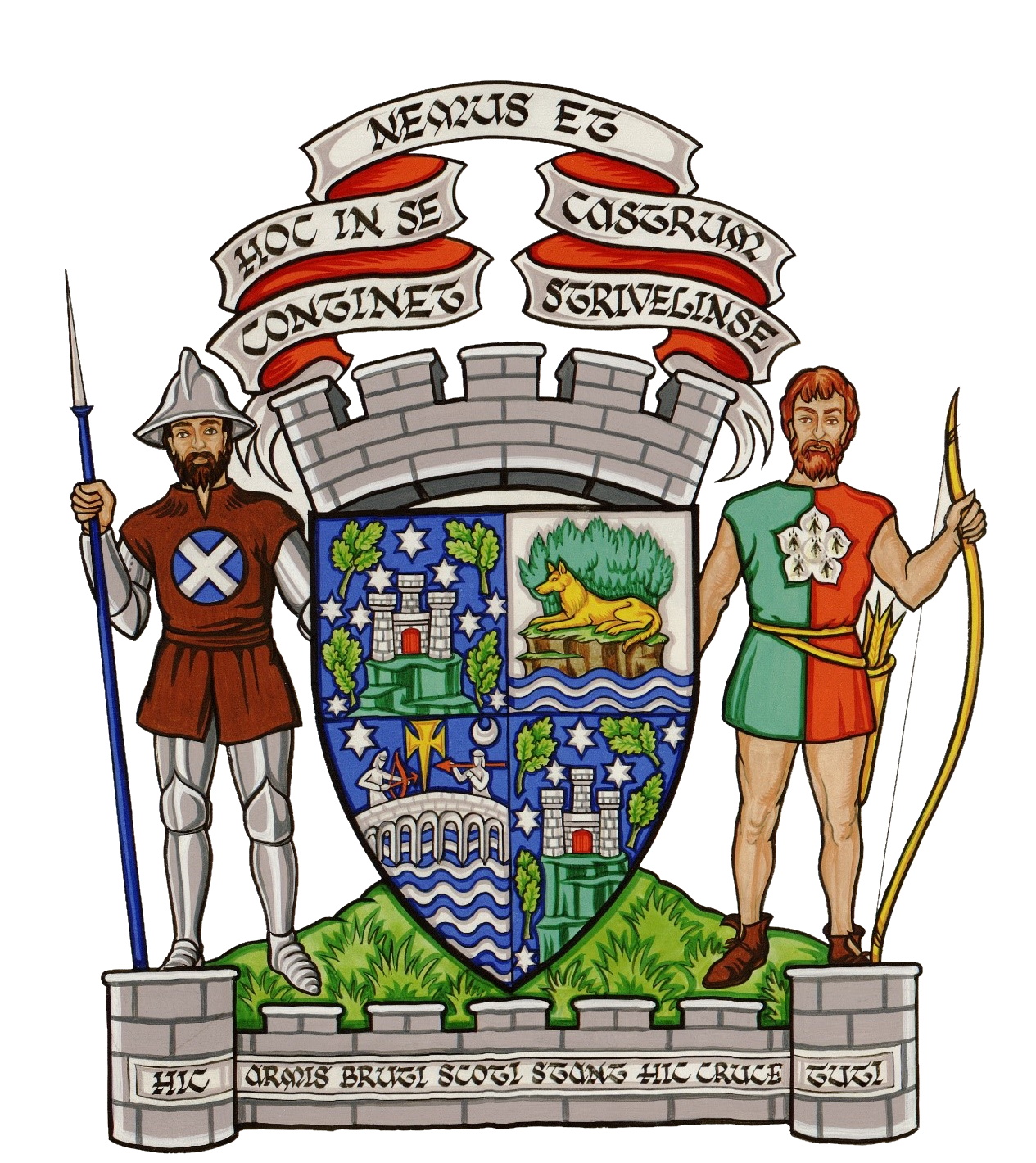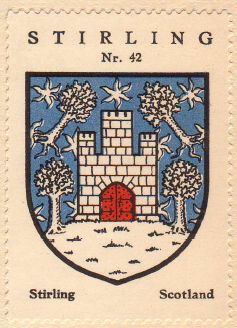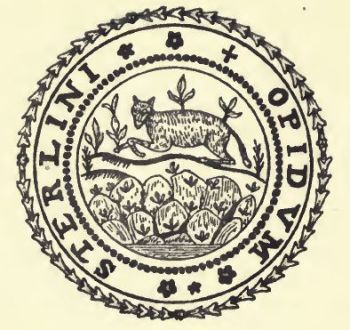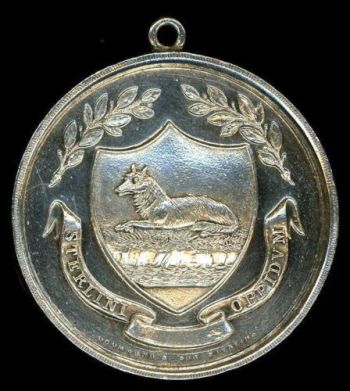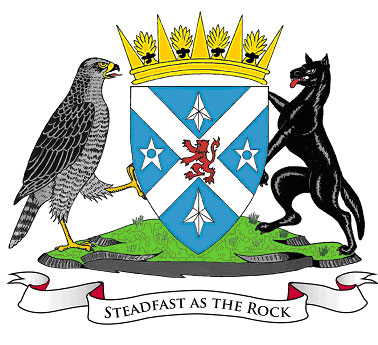Stirling (Scotland): Difference between revisions
Knorrepoes (talk | contribs) No edit summary |
Knorrepoes (talk | contribs) |
||
| Line 37: | Line 37: | ||
{|align="center" | {|align="center" | ||
|align="center"|[[File:Stirlingseal.jpg|350 px|center]] <br/>Seal of the burgh as used in the 1890s with the wolf | |align="center"|[[File:Stirlingseal.jpg|350 px|center]] <br/>Seal of the burgh as used in the 1890s with the wolf | ||
|align="center"|[[File:Stirlingmedal.jpg|350 px|center]] <br/>A medal with the wolf arms (+/- 1910, from auction site) | |||
|} | |} | ||
| Line 49: | Line 51: | ||
The motto below refers to the 3rd quarter but is difficult of translation owing to doubts as to the meaning of the word "Bruti". Some say it means "Britons" and that the motto could mean, "Here stand the Britons protected by arms, here the Scots protected by the Cross". But "Bruti" may refer to a Welsh tribe which possessed much of the Scottish Lowlands in early times. | The motto below refers to the 3rd quarter but is difficult of translation owing to doubts as to the meaning of the word "Bruti". Some say it means "Britons" and that the motto could mean, "Here stand the Britons protected by arms, here the Scots protected by the Cross". But "Bruti" may refer to a Welsh tribe which possessed much of the Scottish Lowlands in early times. | ||
==District Council== | ==District Council== | ||
Revision as of 10:02, 6 October 2015
| Heraldry of the World |
| British heraldry portal Civic heraldry of the United Kingdom |
|
STIRLING
Burgh
Incorporated into : 1975 Stirling District Council of the Central Region (1996 Stirling Area Council)
Official blazon
- (1962)
Quarterly: 1st and 4th, Azure, on a mount in base Vert, a castle triple towered without windows Argent, masoned Sable, the gate closed Gules, surrounded with four oak trees disposed in orle Proper, the field semee of stars of six rays of the Third; 2nd, Argent, issuant from a base undy Azure and of the First, a rock Proper, thereon a wolf couchant Or in front of a thicket of bushes Vert; srd, per fess, in chief Azure, in base undy Argent and of the First, upon an enarched bridge of seven arches Argent, a cross patee fitchee Or issuant from the bridge, accompanied in the dexter and sinister by two men at-arms respectant Argent, that on the dexter holding a drawn bow Gules, that on the sinister a javelin fessways also Gules, and in dexter chief a star of six rays, and in sinister chief a crescent, both Argent.
Above the Shield which is ensigned of a coronet of a Royal Burgh (videlicet: Proper masoned Sable) is, in an Escrol, this Motto "Continet Hoc In Se Nemus et Castrum Strivelinse", and below the Shield on a Compartment suitable to a Royal Burgh, inscribed of this Motto "Hie Armis Bruti Scoti Stant Hie Cruce Tuti", are set for Supporters, dexter, a pikeman armed cap-a-pie, having a leather jacket charged of a roundel Azure, a saltire Argent, and sustaining in his dexter hand a pike, the shaft Azure; sinister, an archer, his legs and arms naked, his feet in brogues, attired in a jupon per pale Vert and Gules, charged on the breast of a cinquefoil Ermine, about his waist a belt and quiver Or, and in his exterior hand a bow also Or.
Origin/meaning
The arms were granted on April 25, 1849 and again on May 3, 1962.
Stirling was made a Royal Burgh between 1124 and 1127 by King David II.
The arms replaced the version recorded in the Lyon Register in 1849; this was almost identical to what is shown in the 1st and 4th quarters of the new coat of arms, see images below.
| The arms as used on a JaJa postcard +/- 1905 |
The arms in the Coffee Hag albums +/- 1925 |
The old arms show the Royal Castle and Forest of Stirling.
Stirling has a most interesting collection of old seals, and in 1960 the Town Council decided to record all its seals; this led to a new grant of arms with supporters and a Royal Burgh compartment. The 1st and 4th quarters show the device on the reverse of the Great Seal of the Burgh and the 3rd quarter, the obverse: there is on record an impression of this seal dated 1296. The 2nd quarter shows the device on another Common Seal used by the Burgh of which a seventeenth-century impression is on record.
In the 1st and 4th quarters are again the Royal Castle and Forest of Stirling; the 2nd quarter shows the wolf on the crag, recalling the rocky crag called the Craigs or the Wolf's Crag, in whose vicinity there is a spring of water which from ancient times was used as the public washing area. There is a legend that during a Danish invasion in the ninth century, the garrison was warned of the enemy's approach by the barking of a wolf on this crag and was consequently able to repel the attack.
In a Town Council Minute of 15 June 1624, the Burgh arms are described as "the wolf upon ane craig".'
| Seal of the burgh as used in the 1890s with the wolf |
A medal with the wolf arms (+/- 1910, from auction site) |
The 3rd quarter shows what are really the sacred bearings of the town. The bridge with its warriors and the cross above it are said to recall the stone bridge and cross built across the river Forth in c. 86o by King Oswald of Northumbria who captured the Scottish King Donald I, and after marching on Stirling was able to secure the cession of all the lands south of the Forth and Clyde. The warriors on the bridge are apparently an English bowman and a Scottish pikeman.
The soldier supporters, as well as alluding to the fighting men in the 3rd quarter, appropriately refer to Stirling's long history as a garrison town. The pikeman with the Scottish saltire on his jacket comes from the time of the War of Independence and the Battles of Stirling Bridge (1297) and Bannockburn (1242). The archer comes from earlier days, possibly from the period of the first Battle of Stirling (c. 86o), and he represents the Highland and Lowland Kingdoms of Scotland, Alba and Strathclyde. His golden arrow and the green half of his tunic are for Alba, the red half and the ermine cinquefoil for Strathclyde.
The Latin mottoes, which come from the oldest known Burgh seal, have been the subject of a good deal of discussion. That shown above refers to the 1st and 4th quarters and has been happily translated in a couplet by Sir Robert Sibbald:
- The Castle and the Wood of Stirling Town
- Are in the compass of this Seal set down.
The motto below refers to the 3rd quarter but is difficult of translation owing to doubts as to the meaning of the word "Bruti". Some say it means "Britons" and that the motto could mean, "Here stand the Britons protected by arms, here the Scots protected by the Cross". But "Bruti" may refer to a Welsh tribe which possessed much of the Scottish Lowlands in early times.
District Council
Additions : 1975 the Burghs Bridge of Allan, Callander, Doune, Dunblane, Stirling and districts
Incorporated into : 1996 Stirling Area Council
Official blazon
Azure, on a saltire between two caltraps in chief and base and as many spur rowels in the flanks Argent, a lion rampant Gules, armed and langued of the First.
Above the Shield is placed a coronet appropriate to a statutory District, videlicet:-a circlet richly chased, from which are issuant - eight thistle-heads (three and two halves visible) Or
Origin/meaning
The arms were granted on June 25, 1975.
These are the former Stirlingshire County council arms with a crown of a district council.
Area Council
Additions : the Stirling District Council of the Central Region
Official blazon
Azure, on a saltire between two caltraps in chief and base and as many spur rowels in the flanks Argent, a lion rampant Gules, armed and langued of the First.
Above the Shield is placed a Coronet appropriate to a statutory Area Council, videlicet:- issuant from a circlet eight paling piles (three and two halves visible) Or and eight garbs (four visible) of the Last, banded Sable; on a Compartment below the shield are set for Supporters, dexter, a goshawk Proper, and sinister, a wolf Sable, armed and langued Gules.
Origin/meaning
The arms were granted on March 18, 1997.
These are the former Stirlingshire County council arms with a crown of an area council and with two supporters.
The dexter supporter, a goshawk, was the dexter supporter of the arms of Central Regional Council; the sinister supporter, a wolf, comes from the arms of the royal burgh of Stirling (see above).
Contact and Support
Partners:
Your logo here ?
Contact us
© since 1995, Heraldry of the World, Ralf Hartemink 
Index of the site
Literature : Porteous, 1906; Urquhart, 1974, 1979, 2001


